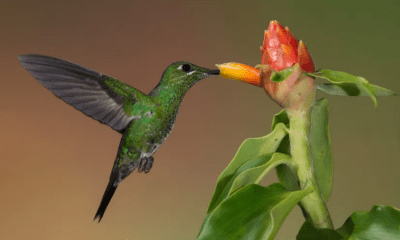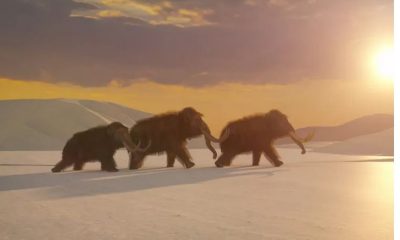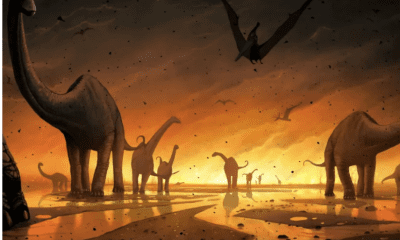Environment
What will happen to the earth if humans become extinct?
Published
1 week agoon


What will happen to the earth if humans become extinct?
Deep in the rainforests of Guatemala lies one of the famous remains of the Mayan civilization: an almost two-thousand-year-old fortress called Tikal, the ruins of which remain. When Alan Wiseman, a writer and journalist, was walking around the area, he discovered an interesting problem along the way. He said you are walking through this dense rain forest and walking on the hills, But what you are walking on are actually unexplored pyramids and cities. In other words, we know about places like Tikal; Because humans have dug up and removed their remains. Meanwhile, countless other ruins remain hidden under the forests and the ground. It is very shocking how fast nature is burying us in itself. This rainforest scene gives us a chance to see what the earth would look like if humans disappeared.
Recently, the issue of the absence of humans and its effect on the earth has been particularly in the spotlight; Because the globalization of COVID-19 has kept humans indoors encouraged animals to come to urban environments, and has made us wonder what life would look like if we remained isolated. Wiseman, the author of The World Without Us, has spent several years interviewing experts and systematically investigating the question of what would happen to our planet (to cities and industries and to nature) if humans disappeared.

There are several theories about the causes of human extinction, and it seems unlikely that we will simply disappear overnight. However, imagining the sudden and complete eradication of humans from the earth by an undiscovered human-specific virus is perhaps the most powerful way to explore what would happen if humans disappeared from the planet. This question has drawn Weissman’s attention to the places where some dramatic and immediate changes have appeared due to the sudden lack of human maintenance. Without humans to divert rainfall and groundwater, the subways of vast cities like London and New York will flood within hours of our destruction. “I’ve been told by engineers that it takes about 36 hours for the underground passages to be completely flooded,” Wiseman said. In the absence of human supervision, breakdowns in oil refineries and nuclear power plants will not be repaired and will likely lead to massive fires nuclear explosions, and devastating radioactive rains.
As such, we leave behind a mass of waste, much of it plastic, that will likely remain for thousands of years, with effects on wildlife that we are only just beginning to understand. Meanwhile, microbes and plants break down and use the oil waste dumped in or infiltrated into industrial sites and factories, and this process may take decades. Persistent organic pollutants will take much longer to decompose. Some of these persistent organic pollutants may almost never degrade, But in the end, they are buried safely.
Undoubtedly, the combination of rapid and slow release of pollutants we leave behind will have devastating effects on surrounding habitats and wildlife; But this does not necessarily mean complete destruction. It is enough to look at the return of wildlife at the site of the Chornobyl disaster to understand how nature can resist on short time scales and even in such extreme cases.
Meanwhile, the waters flowing under the cities will rot the metal structures supporting the roads and the entire roads will collapse and turn into rivers in the middle of the city. In consecutive winters and without human deicing, the surfaces of the streets are broken and new spaces are prepared for seeds to take root, which are brought there by the wind and birds and become trees that continue to destroy the roads. The same thing will happen to bridges. Without the presence of humans to remove the hardy plants that take root between the steel spacers and the general destruction of these structures, they will be destroyed within a few hundred years.
Seeking to create new habitats, nature gets to work and trees grow in the created spaces. This leads to the accumulation of dry organic matter such as leaves and branches and provides suitable fodder for lightning-caused fires that engulf entire buildings and streets and can raze entire cities to the ground. As a result of the fires, burnt materials are produced which fall into the streets and are perfect for growing life.
In 500 years, the streets will turn into meadows and small forests, and in hundreds of years, the buildings will be destroyed due to continuous damage caused by erosion and fire. The first thing to fall are the modern glass and metal structures that break and rot; But the buildings that will last the longest are those built from the earth itself; Like stone structures. Of course, their landscape will also change.
Where the creatures are wild
A rapid recovery of insects will occur within the confines of agricultural fields, which currently cover half of the Earth’s inhabited land; Because with the destruction of humans, the use of pesticides and other chemicals will stop. This starts a cascade of events. When the condition of the insects improves, the condition of the plants and the birds also improves. Surrounding habitats (plant communities, soils, waterways, and oceans) will be restored by being freed from the effects of chemicals. This in turn encourages wildlife to move and settle, and this migration will increase biodiversity on a global scale.
Researchers who have modeled the diversity of large animals (such as lions, elephants, tigers and rhinos and bears) have shown that the Earth was once rich in these species; But when humans spread over the earth and hunted animals and invaded their habitats, the situation changed.
Søren Furby, a lecturer in ecology and evolution at the University of Gothenburg, Sweden, explained:
As humans migrated from Africa and Eurasia to other parts of the world, extinction rates increased as they entered new areas. In Australia, there is an increase in extinction around 60,000 years ago, and in North and South America, an increase in extinction around 15,000 years ago, and in Madagascar and the Caribbean islands, a significant increase in several thousand years ago.
Without the spread of humans across Earth and the decline of large animal populations, Forby said, the entire planet could be as rich in species diversity as the Serengeti National Park in East Africa. In fact, large animals used to exist everywhere, and if it were not for human intervention, there would be large animals in all regions of the earth today. His research has shown that without human influence on large species, the central parts of the United States and parts of South America would be rich places on Earth in terms of large animals. Animals such as elephants will be a common sight on the Mediterranean islands, and even rhinoceroses will be seen in most parts of northern Europe.
Can Earth regain its past biodiversity without humans? According to Forby and his colleagues’ calculations, even if we suddenly disappeared from Earth’s scene, it would take millions of years for Earth to recover from past extinctions. “It will take something like three to seven million years or more for the Earth to return to its pre-extinction state,” explained Jens Christian Sonning, professor of ecology and biogeography at Aarhus University in Denmark. “Basically, if there were no human impacts, the whole earth would be one big untouched nature.”

Nature finds a way
Planet Earth may eventually become greener and more diverse; But we cannot ignore the effects of climate change, which is probably the most persistent human effect on Earth. Weissman points to the lack of confidence in predicting the future of the Earth. For example, if there are explosions at industrial plants or oil or gas resources that continue long after we are gone, large amounts of carbon dioxide will enter the atmosphere. Carbon dioxide does not stay suspended in the atmosphere forever. Oceans play an essential role in absorbing carbon dioxide from the air, But oceans also have tolerance limits. Water acidification can harm thousands of marine species. It appears that it will take thousands of years for the current levels of carbon dioxide in the atmosphere to be completely removed from the atmosphere. According to Wiseman’s research, this process can take 100 thousand years.
If the sea reaches its maximum capacity and many greenhouse gases remain in the atmosphere, the resulting continued warming will lead to the melting of more polar ice caps and the release of more greenhouse gases from the permafrost, further creating a progressive climate-changing feedback loop. Therefore, it is safe to assume that the effects of climate change will persist long after our demise; But in this context, Wiseman says something promising. He says that during the Jurassic period, the amount of carbon dioxide in the atmosphere was five times the current amount, which led to a significant increase in the acidity of the ocean. During that time, some marine species were able to withstand the conditions and evolve into what we see on Earth today. Weissman said that in the end, despite the severe climatic conditions and the severe damage caused by it, nature finds its way. There may one day be a world without humans, But this does not prevent other members of the planet from continuing.


You may like
-




The Secret of the Hummingbird’s Amazing Adaptation
-




Why does Everest get higher every year?
-




Do animals have an understanding of the concept of death?
-




Mammoth and dodo return to nature
-




If the dinosaurs did not become extinct, what would our world be like today?
-




Launching a satellite to investigate the role of clouds in changing the Earth’s climate


The Secret of the Hummingbird’s Amazing Adaptation: From Digestive System to High-Altitude Flight
Summary of the article:
- The hummingbird is a small bird with amazing abilities. This bird can fly forward, backward, and even upside down. They feed on nectar and enter a state similar to a human coma at night to save energy.
- Hummingbirds have a special digestive system that quickly absorbs sugar without causing complications such as diabetes. These birds are also adapted to life at high altitudes and cope with thin air and lack of oxygen with their own adaptations.
- Some species of hummingbirds migrate a long distance of up to 8 thousand kilometers. In these paths, they not only face environmental challenges but also adapt their bodies to harsh conditions.
- Researchers are now studying the specific characteristics of hummingbirds. Using new technologies, they plan to gain a greater understanding of the specific adaptations of these birds and their applications in the treatment of diabetes and energy optimization in humans.
The hummingbird is one of the most amazing birds known for its fast flight and ability to hover in the air. With their special diet consisting mainly of nectar, in addition to non-stop flight, these small birds also have other unique abilities such as upside-down flight and backward flight. These birds with a very high metabolism consume nectar as much as 80% of their body weight daily and have a special digestive system to prevent problems such as diabetes.
The hummingbird’s digestive system absorbs sugar quickly. To conserve energy during cold nights or when there is a lack of food, they fall into a state similar to a human coma and reduce their body temperature to near the ambient temperature. Despite many biological challenges, such as tolerating high blood sugar levels and long migrations, hummingbirds continue to live in harsh conditions with their critical and exceptional adaptations.
Most people enjoy watching the beautiful little hummingbirds. Native to the Americas, these colorful creatures fly fast, hover among flowers, and tenaciously defend their territory and food sources.
But to the scientists who study these birds, hummingbirds are much more than an entertaining show. Their small size and high metabolism mean that these birds live on the edge. Sometimes they have to completely shut down their bodies or even migrate thousands of kilometers to save the energy needed to survive during the night. The migration route also sometimes passes through the oceans.
A diet rich in hummingbird nectar leads to blood sugar levels that can cause a person to fall into a coma. A hummingbird’s high-speed flight produces such intense G-forces that it can even knock a fighter pilot unconscious. Researchers say that the more they study these birds, the more hidden surprises they find in their small bodies; The body is one of the smallest in the world of birds.
“They are the only birds in the world that can fly upside down and backward,” says Holly Ernst, a conservation ecologist at the University of Wyoming. “They drink pure sugar and they don’t get diabetes.”
Ernst is one of the few researchers who researches how hummingbirds adapt to the extreme pressures of their lifestyle. In the following, we will review some things that scientists have discovered about the unique adaptation of hummingbirds.
Continuous effort
For years, most researchers believed that hummingbirds spent only about 30 percent of their day engaged in energetic activities such as flying from flower to flower and drinking nectar, and spent most of their time resting. But physiological ecologist Anusha Shankar observed these birds closely and found that they often work much harder than previously thought.
The life conditions of hummingbirds are much more difficult than our imaginations
Shankar, who now works at the Tata Institute of Fundamental Research in Hyderabad, India, tried to understand how the broad-billed hummingbird, native to southern Arizona, lived its life. Using different experimental methods, he measured the metabolic rate of these birds in different activities and estimated their total daily energy consumption. By adding previously published data, Shankar was able to calculate the amount of energy consumed by these birds for each minute of sitting, flying, and hovering, i.e. the three main ways a bird spends time.
Shankar then deduced how much time the hummingbirds spent feeding and sitting during the day. Hummingbirds spend most of their time feeding on nectar but hardly feed when flowers are scarce.
“We found it to be very variable,” says Shankar. In early summer, when flowers were plentiful, birds could meet their daily energy needs with just a few hours of feeding and spend up to 70 percent of the day resting. But with the onset of summer monsoons, flowers became scarcer. In one of the areas, the birds spent only 20% of their waking hours sitting and spent the rest of the day feeding.
Shankar says: “That means 13 hours a day! I can never spend 13 hours a day running. “I don’t know how they do it.”
 Ruby hummingbird.
Ruby hummingbird.
Cool birds
Hummingbirds use a special trick to make the most of their energy reserves: when the bird is in danger of running out of energy, it goes into hibernation or false death at night. In this dormant state, the bird’s body temperature drops to about the same temperature as the surrounding air, sometimes only a few degrees above freezing. When the bird is asleep, it is almost comatose, unable to react quickly to stimuli around it, and breathing only intermittently.
According to Shankar’s calculations, the hibernation strategy can reduce up to 95% of the energy required for hourly metabolism on cold nights. Positioning in this position is critical after days when the bird has fed less than usual, such as days after a storm. Also, it helps the birds to store energy and increase their body fat before migration.
The hummingbird goes into a state of false death at night to save energy
Shankar is now investigating the hibernation strategy further, to find out which body parts the hummingbirds prioritize during this state and which gene products are essential for them to be present. “If you’re a hummingbird running on 10 percent of your natural metabolism, what’s that 10 percent that keeps you alive?” he asks.
One class of genes that seem to remain intact during hibernation are those responsible for the bird’s internal clock. “It’s important for them to do things at the right time, even when they’re asleep,” says Shankar. For example, in order for a bird to start the day well, it starts to wake up about an hour before sunrise, much earlier than receiving visible light cues.
Dealing with sugar
Hummingbirds consume about 80% of their body weight in nectar every day in order to provide the energy needed for their very high metabolism. This amount of nectar is equivalent to a person weighing about 70 kg drinking approximately 100 half-liter cans of soda daily. Of course, nectar is often much sweeter than soda.
The human intestine cannot absorb sugar at such a speed. According to Ken Welch, a comparative physiologist at the University of Toronto Scarborough, one of the causes of stomach disease in humans comes from overconsumption of soda or candy. Hummingbirds have leaky guts to deal with the onslaught of sugar. That is, the sugar in such an intestine enters the bloodstream not only through the intestinal cells but also through them. In this way, sugar is quickly removed from the intestine before it causes discomfort. Fast sugar transport, and possibly other adaptations, allow hummingbirds to reach blood sugar levels up to six times higher than those found in humans.
Hummingbird gut is leaky
A very high amount of sugar in the blood can lead to serious physical problems in humans. High blood sugar leads to more binding of sugar to proteins in the body; This process is known as glycation. During the glycation process, blood sugar combines with body proteins and changes their structure. In the long term, excessive glycation can cause several complications such as diabetes and nerve damage.
Welch says it’s not yet clear how hummingbirds avoid problems like glycation, but researchers are getting clues. For example, a study shows that avian proteins have fewer glycation-prone amino acids than mammalian proteins, and other amino acids are usually deep in the protein, meaning they are less exposed to circulating sugars.
Other unknown strategies for dealing with hyperglycemia may have practical benefits for the management of diabetes in humans in the future. “There may be a gold mine in the hummingbird genome,” Welch says.
Metabolic change
One of the challenges that hummingbirds face is the change in metabolism at the end of the day. In addition to this challenge, the nectar diet also involves issues such as high water consumption. Now, let’s take a look at the adaptations of these birds in the face of both challenges.
By the end of the overnight fast, hummingbirds almost completely deplete their body’s sugar reserves. This creates the challenge of reverse metabolism. “How does this bird wake up and fly?” asks Welch. There is nothing left but fat to burn.”
Welch found that hummingbirds are remarkably capable of switching their metabolism from burning sugar to burning fat. “This action requires a huge change in the biochemical pathways involved in the process,” he says, and the change occurs within minutes, much faster than in other organisms. He adds: “If we could also have such control over our fuel consumption, we would be very happy.”
Saving water
Sugar isn’t the only challenge of a nectar-rich diet. After all, nectar is mostly water, and birds that drink such large amounts of fluid must excrete a lot of it without losing electrolytes. For this reason, the kidneys of hummingbirds are specially adapted to absorb electrolytes before re-excreting them. “These birds excrete distilled water,” says Carlos Martínez del Río, a retired physiological ecologist from the University of Wyoming.
Hummingbirds also turn off their kidneys at night
But there is another problem: if the hummingbird produced dilute urine at night, it would die of dehydration before morning. To prevent this, hummingbirds turn off their kidneys every night. “They go into a state that, in humans, is similar to acute kidney failure,” says Martínez del Río. “The hummingbirds have to do this, or they will die out.”
High altitude flight
The metabolic needs of hummingbirds at sea level also become tough enough. But many species live at high altitudes. The thin air at high altitudes has less oxygen and provides less resistance to the air when suspended. For example, the giant hummingbird, the world’s largest hummingbird, lives in the Andes mountains at an altitude of more than four kilometers, higher than many helicopters. According to Jesse Williamson, an ornithologist from Cornell University, to cope with such conditions, the hemoglobin in the blood of these birds is richer.
But some hummingbirds face bigger challenges. The giant hummingbirds are so large that researchers can attach satellite tracking tags to them, as well as smaller locators. So Williamson and his colleagues decided to equip these birds with trackers. After thousands of hours of trying to capture the birds using nets, the researchers were able to attach the trackers to 57 birds using custom-made straps made from jewelry-making straps.
 Tracking data of giant hummingbirds during migration from Chile to the Andes.
Tracking data of giant hummingbirds during migration from Chile to the Andes.
Although tracking data was recovered from only eight birds, even this small sample yielded a big surprise: some birds live year-round in the Andes, while others, a separate, previously undetected species, migrate from the breeding grounds every year. They migrate to the Andes mountains on the coast of Chile. This means that birds not only face the obvious challenges of a long migration (a round trip of almost eight thousand kilometers) but also have to adapt to thinner air.
The secret of hummingbirds is gradual adaptation to the conditions
But what is the secret of hummingbirds? They gradually adapt to the conditions. “Their work is similar to the way human climbers climb peaks like Everest, climbing and taking breaks to get used to the conditions,” Williamson says. “The journey takes months.”
As access to lighter and cheaper tracking technology improves, researchers like Williamson hope to be able to track even smaller species of hummingbirds. Tracking, along with other advances in research technology, may hold many surprises about the biology of these amazing little birds.


rockNoun: A formation of minerals, specifically:
Noun: A large hill or island having no vegetation.
Noun: Something that is strong, stable, and dependable; a person who provides security or support to another.
Noun: A lump or cube of ice.
Noun: A type of confectionery made from sugar in the shape of a stick, traditionally having some text running through its length.
Noun: A crystallized lump of crack cocaine.
Noun: An unintelligent person, especially one who repeats mistakes.
Noun: An Afrikaner.
Noun: An extremely conservative player who is willing to play only the very strongest hands.
Noun: Any of several fish:
Noun: A basketball.
Noun: A closed hand (a handshape resembling a rock), that beats scissors and loses to paper. It beats lizard and loses to Spock in rock-paper-scissors-lizard-Spock.
Noun: A cricket ball, especially a new one that has not been softened by use
Noun: A crystal used to control the radio frequency.
Verb: To move gently back and forth.
Verb: To cause to shake or sway violently.
Verb: To sway or tilt violently back and forth.
Verb: To be washed and panned in a cradle or in a rocker.
Verb: To disturb the emotional equilibrium of; to distress; to greatly impact (most often positively).
Verb: To do well or to be operating at high efficiency.
Verb: To make love to or have sex (with).
Verb: To sway one’s body as a stim.
Noun: An act of rocking; a rocking motion; a sway.
Noun: A style of music characterized by basic drum-beat, generally riffs, based on (usually electric) guitar, bass guitar, drums, keyboards (often), and vocals.
Verb: To play, perform, or enjoy rock music, especially with a lot of skill or energy.
Verb: To be very favourable or skilful; excel; be fantastic.
Verb: To thrill or excite, especially with rock music.
Verb: To have people dancing and enjoying rock music.
Verb: To do something with excitement yet skillfully.
Verb: To wear (a piece of clothing, outfit etc.) successfully or with style; to carry off (a particular look, style).
Noun: The flax or wool on a distaff.
Noun: (mythical bird)
Why does Everest get higher every year?
How did Everest become the highest mountain in the world with a difference of more than 200 meters from the next two highest peaks? Geologists say the mountain owes part of its extra height to two ancient rivers that flowed through the Himalayas and merged years ago. The erosion from the new river washed away so much rock and soil that Everest moved up to 50 meters more.
Matt Fox, a geologist at University College London and one of the authors of a new paper that examines the mystery of Everest’s height, says that the outer crust of the Earth responds to the removal of mass by gradually rising, and this is what caused the height of Everest to rise.
Rivers cause erosion, but the effects they have on the land can be unexpected. About 89,000 years ago, a powerful river combined with another river became more erosive. This merging washed away more of the Himalayan land, and the enormous weight of the crust separated the layer of earth we live on.
Mountains may seem static, but they are always moving
At over eight kilometers or 8,848 meters high, Mount Everest is the tallest mountain on Earth and still growing. At almost 250 meters higher than the second-highest peak in the Himalayas, it is unusually tall even for this mountain range. The next three highest peaks differ by only about 120 meters in height.
The large height difference between Everest and other mountains can be partly explained by the uplift force caused by the pressure under the Earth’s crust. The underground pressure started after the erosion of a large amount of rock and river soil, which is a geological phenomenon called isostatic reaction. Revival occurs when a part of the Earth’s crust that loses mass bends and floats upward due to the intense pressure of the liquid mantle beneath it. The upward pressure is greater than the downward gravitational force after the shell loses mass.
Isostatic rebound is a gradual process, moving only a few millimeters per year, but it can significantly affect the Earth’s surface over time.
The isostatic reaction has contributed to the growth of Mount Everest
The lightweight crust was able to float more easily above the lower layer, the mantle, adding 15 to 50 meters of height to Everest, the study says.
“Although mountains may seem static in terms of human life, they are actually constantly moving,” said Jinzhen Dai, a geologist at the China University of Geosciences in Beijing and the author of the paper. Although the paper can only explain part of Everest’s extra height, scientists see it as a step toward calculating how the mountain grew to its current height.
The formation of Mount Everest began about 45 million years ago when the Indian tectonic plate collided with the Eurasian plate. This collision caused a part of the earth’s crust to bend and fold on a huge scale, creating the Himalayas.
 Aron River.
Aron River.
Although the Earth’s crust appears solid, it is not. When something massive, like an ice sheet or mountain range, weighs down the crust, it bends downward; But the lower mantle is buoyant and pushes the overhanging crust upward.
When the crust neither rises nor sinks, it is in isostatic equilibrium, and Everest must be in that state. As the Indian tectonic plate moves down, it adds new material to the Himalayas, causing the mountains to grow. At the same time, rain, snow, and glaciers wash the surface of the mountain and remove rocks and materials.
The forces of material addition from below and erosion from above must cancel each other out, meaning that Everest does not grow or shrink; But the fact that Everest keeps getting taller suggests that something is upsetting this balance. One possible reason is the erosive river, which strips the surrounding land of material that weighed down the mountain, allowing Everest to rise higher.
In the shadow of Everest is the Aron River, which, like this peak, is more distinct from the surrounding rivers. The Arun takes an unusual course, first flowing along the northern Himalayas and then twisting and turning over the ridge near Everest. This shows that the upper and lower parts of the river were not always connected and that some important event caused the connection.
By simulating the rivers of the region in computer simulations, the researchers found that about 89,000 years ago, another river network gradually eroded and made its way toward the Himalayas until it finally connected to the Arun River. When these two rivers joined together, the first river took the flow of water from Arun and made it part of its network.
The Himalayas could not cope with the erosion power of the river and the crust on top of it was pushed towards the sky by the floating mantle sea, various peaks rose and Everest gained up to 50 meters of additional height.
The tallest mountain on Earth is still growing, growing by the width of a spaghetti strand every year. A combination of factors, including crustal rebound, explains Everest’s height. But Everest’s growth spurt probably won’t last forever. The balance may tip the other way and reduce the height of Everest. Like all mountain ranges, the Himalayas will go up and down.
The findings of the study have been published in the journal Nature Geoscience.
Environment
Do animals have an understanding of the concept of death?
Published
2 months agoon
16/09/2024

butPreposition, except (for), excluding.
Preposition: outside of.
Adverb: merely, only, just, no more than
Adverb: though, however.
Conjunction: except that (introducing a subordinate clause which qualifies a negative statement); also, with omission of the subject of the subordinate clause, acting as a negative relative, “except one that”, “except such that”.
Conjunction: Without it also being the case that; unless that (introducing a necessary concomitant).
Conjunction: Except with; unless with; without.
Conjunction: Only; solely; merely.
Conjunction: until.
Noun: An instance of using the word “but”; an objection or caveat.
Noun: The outer room of a small two-room cottage.
Noun: A limit; a boundary.
Noun: The end; especially the larger or thicker end, or the blunt, in distinction from the sharp, end; the butt.
Verb: Use the word “but”.
Do animals have an understanding of the concept of death?
A chimpanzee named Muni had just been brought to a zoo in the Netherlands when she lost her child. The zookeepers did not know that she was pregnant. Zoe Goldsborough, a student who spent months studying and recording social interaction among chimpanzees, did not know this either.
One cold winter morning, Goldsborough saw Mooney sitting alone on a tree trunk in the center of the compound, holding something in her arms. It wasn’t unusual for Muni to be alone, as she had trouble bonding with the zoo’s 14 other chimpanzees. But when Goldsborough approached him, he knew something was wrong. Muni was holding a baby in her arms and the baby was not moving.
Goldsborough rushed to the room where the zookeepers were preparing food for the chimpanzees and told them what he had seen. At first, they didn’t believe Goldsboro’s words and said that Mooney was probably playing some tricks. But after the guards saw the baby with their own eyes, they entered the compound and tried to take it from Muni. Mooney wouldn’t let go and the guards decided to wait for a while and then try again.
At this moment, another female chimpanzee named Toshi was roaming around Muni. Toshi was one of Goldsboro’s favorite chimps. A few years ago, he became world-famous for a planned attack on a drone that was filming chimpanzees. Toshi had experienced a miscarriage long before. Maybe for Toshi, seeing Muni and her baby was a reminder of that old memory or similar feelings. Over the next two days, she stayed close to Mooney, while Mooney still held her baby’s body in her arms.
Finally, in a struggle with the guards, the body falls from Mooney’s hands, Toshi takes it and refuses to give it back. Muni was very angry. The guards put Toshi in a separate room and Muni angrily bangs on the door. Goldsborough was not sure about the cause of this behavior. Mooney seemed to be under the influence of intense maternal attachment, and Toshi was perhaps reacting to a repetition of feelings she had experienced in the past.
It is unclear whether any of the chimps actually understood what had happened to the child. Maybe they mistakenly thought the child would come back to life. Even though chimpanzees are our closest relatives in the tree of life and one of the most well-studied animals, we still cannot interpret their behavior with certainty.
An old question

Last June, more than 20 scientists gathered at Kyoto University in Japan for the largest-ever conference on comparative morphology (the study of animals’ experience of death). Although this scientific field is small, its works date back to the time of Aristotle. In 350 BC, Aristotle wrote about a pair of dolphins he saw coming to the surface of the Aegean Sea supporting a dead baby, “out of compassion trying to prevent it from being eaten.”
Much of the scientific literature on comparative mortology contains similar stories. Some of them are short, like Aristotle’s story, and some, like the story of Muni and her baby, published in 2019 in the journal Primates, contain much more social detail.
Scientists want to find out what emotions animals experience when they lose loved ones. They are trying to understand if animals fear death like we do. However, there are many obstacles in the way of studying this issue. Researchers cannot interview animals. While hormonal changes can be observed (cortisol levels rise in bereaved baboons), these changes may be caused by other stressors.
So far, the best comparative mortality data have come from observing animals in the wild or captive animals in zoos, but even here there are problems.
Species with more interesting responses to death (such as nonhuman primates, whales, and elephants) have long lifespans and low mortality rates in their societies. Obtaining systematic data on their response to death usually requires years or even decades of study.
Alecia Carter, an evolutionary anthropologist at University College London, says she has identified a group of about 1,000 rhesus monkeys on Cayo Santiago Island, off Puerto Rico, that would be ideal for such studies. Rhesus monkeys are very social and usually live 15 to 20 years, which is enough time to establish deep relationships; But it is not so long that deaths among them are very rare.
Understanding of death

Humans have spent months in hot, humid forests or zoo enclosures and overcome difficult obstacles to study animals’ reactions to death. Anyway, we humans have been sensitive to death, if not very much, at least since the beginning of written history. The oldest work of epic literature tells the story of King Gilgamesh and his struggle with death. “Death is sitting in my bedroom and everywhere I turn, I feel death,” he says, searching for a plant that promises immortality.
Between the ages of 4 and 7, human children learn that death is an irreversible situation
Human cultures have devised symbol-laden rituals for the pre-death and post-death periods. For more than 10,000 years, we have buried our lost children in the ground and planted flowers around them. We are the species of faithful guardians of tombs, builders of pyramids, and inventors of various funeral ceremonies. We have envisioned the afterlife both in heaven above and here on earth on the wheel of reincarnation. Our philosophers have also dealt with the issue of death in a very subtle way, and their definitions of death currently exceed 10,000 words.
We humans have even extended our finitude to the universe itself. Scientists tell us that trillions of years from now, after the last galaxies have collapsed and the black holes have vaporized bit by bit, the entire universe will be destroyed.
As humans, our complex ideas about death are not passed on to future generations through our genes. They are formed in people’s minds over time and gradually accumulate in our culture. Human children usually learn between the ages of 4 and 7 that death is not temporary or irreversible, and if they lose a family member or pet, they may understand this a little earlier.
In a new book, ” Pretending to Die: How Animals Understand Death, ” Spanish philosopher Susana Monceau argues that many other animals probably understand the same simple concept of death (i.e., loss of agency). Of course, without access to their minds, we cannot be sure about this.
Mammals, fish, birds, reptiles, and insects are all aware of agency in the natural world. They monitor their environments for movement and differentiate between stationary objects and things that move in some way to achieve their goal. Some of them behave in ways that show they understand that other animals may lose this ability forever. But we don’t know whether these behaviors are caused by the understanding of death or simply by instinct.
Pay attention to the termites. At the June meeting in Kyoto, an entomologist from Louisiana State University presented a paper on carcass management methods in eastern groundhogs. More than a million of these insects may congregate in nested subterranean colonies tens of meters wide. When worker ants encounter a dead mate in one of the colony’s tunnels, they react differently depending on the condition of the corpse. When the corpse is fresh, they eat it; But they bury old and rotten bodies. Other social insects that live in similar environments behave in similar ways. Bees remove dead bodies from the hive, but these behaviors do not appear to be caused by an understanding of the concept of death.
Termite corpses produce oleic acid, which apparently stimulates burial behavior. When the American biologist Edward Wilson smeared a live ant with this substance, the members of the colony immediately assumed him dead and took him out of the colony, even as he moved his legs in protest.
Death is a complicated concept for us

Chimpanzees are not like termites. Their large and complex brains are better able to understand concepts such as death, and there is evidence that they experience an emotion similar to grief.
Several species of non-human primates will gather around a recently deceased member of the community and in many cases gently touch the lifeless body. The population usually disperses slowly and regularly: those who were closest to the dead animal stay longer. Jane Goodall observed that an eight-year-old chimpanzee stayed with its mother’s corpse so long that it died.
Other mammals also usually gather around their dead. While doing this, the giraffes shake their necks at the scavengers to keep them away. In India, the bodies of five young elephants were found covered in twigs and leaves, leading some scientists to believe they were buried by other members of the group.
Andre Gonsalvez, a comparative morologist at Kyoto University, cautions against paying too much attention to this story. According to him, the elephants were found in the pit; This means that they could have fallen inside them, and leaves and dirt could have accidentally piled up on the bodies as their families tried to pull them out.
Monceau reminds his readers that animals live in a violent and bloody world where predators attack in the dark of night or appear from unseen heights with sharp claws.
The violent environment of animal life provides rich conditions for understanding death. Monceau gives the example of a young stag watching a battle between two older stags for power. After their antlers clash several times and the weaker rival fails to rise, the young deer begins to understand the basics of death. If he does not remember this lesson, he will probably have many opportunities to learn it again.
Even if chimpanzees understand the concept of death, it is not as complicated for them as it is for us
Gonsalves isn’t sure if animals learn the meaning of death in their communities and says many animals eat other animals while they’re still alive. It is not clear if they are trying to cause their death or if they perceive it as a separate state of existence. They might just be trying to get a moving food source into their mouths, like frogs, who stick out their sticky tongues at anything that looks like a moth simply as an instinctive reaction.
Among chimpanzees, acts of brutal violence, including murder, indicate a deeper understanding of death. Chimpanzees, like wolves and lions (and humans), sometimes cooperate to kill rival group members. These attacks may be planned in advance. Two or three males enter an area occupied by another group. They move quickly and cautiously, and even when they pass food sources, they don’t stop to eat. They choose single targets and coordinate their attacks so that they don’t get hurt themselves. In some cases, the attacking chimpanzees will continue their attacks even after the victim has surrendered, only stopping when the victim stops breathing.
Obviously, even if chimpanzees understand the concept of death, it is not as complex for them as it is for us. Humans know what death is and they know that one day it will come to them.
James Anderson, professor emeritus of Kyoto University and known as the father of comparative mortology, says chimpanzees feel about their own death in a different way than we humans do. Despite thousands of hours of observation, he says, no one has ever seen a chimpanzee attempt suicide. According to Anderson, only an animal that knows it can die tries to bring about its own death. He says that the lack of reliable reports of suicidal behavior in chimpanzees or any other animal suggests that the existential burden of death is uniquely ours.
Of course, Anderson, as well as other scientists specializing in the field of comparative mortality, still cannot provide the final answer. They can tell us that chimpanzees understand death better than termites, but the rest is unknown and may never be revealed. We can only hope that as we continue to study chimpanzees, we will see new behaviors from them that will reveal more of their inner world.
The story of Muni and her baby may be one of these cases. After the zookeepers left Toshi alone, they decided to calm things down. They kept him away from others until the next day. Meanwhile, everything had changed for Mooney.
Muni used to have trouble interacting with other chimps and used to pull the hair of other female chimps tightly during grooming. He often sat too close to them and stared at them inappropriately. The day Toshi returned to the group, Mooney was surrounded by other chimpanzees. When he saw Toshi, he quickly got up and slapped him.
Toshi did not react, and over the next 30 days, she and the other chimps interacted more with Moony. No other chimpanzee experienced such an increase in attention, and almost all chimpanzees participated in this display of attention. They hugged Moony and petted her more, but they didn’t share the attention equally. Some took care of Muni more than others and Toshi took care of him most of all. It seemed that an important topic had been exchanged between these two chimpanzees. A few months later, things in the compound were largely back to normal. Muni was no longer being petted and the males started harassing her again. But Toshi and Muni often sat together and this close relationship continues to this day.


What is the difference between CPU and GPU?


Maybe the Earth is not doomed by the death of the sun


A look at the structure of the eye and the mechanism of vision


MSI Prestige 16 AI review; A laptop that does not run out of charge


Migraine: symptoms, prevention and treatment


The new version of Copilot was unveiled; Microsoft artificial intelligence


How to solve the problem of slow charging of the Android phone?


Why does Everest get higher every year?


Everything about Cybercube and Robo Van; Elon Musk’s robotic taxis


The wonderful world of ultrasound
Popular
-



 Technology1 year ago
Technology1 year agoWho has checked our Whatsapp profile viewed my Whatsapp August 2023
-



 Technology1 year ago
Technology1 year agoSecond WhatsApp , how to install and download dual WhatsApp August 2023
-



 AI2 years ago
AI2 years agoUber replaces human drivers with robots
-



 Technology1 year ago
Technology1 year agoHow to use ChatGPT on Android and iOS
-



 Technology1 year ago
Technology1 year agoThe best Android tablets 2023, buying guide
-



 Technology1 year ago
Technology1 year agoThe best photography cameras 2023, buying guide and price
-



 Humans2 years ago
Humans2 years agoCell Rover analyzes the inside of cells without destroying them
-



 Technology1 year ago
Technology1 year agoHow to prevent automatic download of applications on Samsung phones
